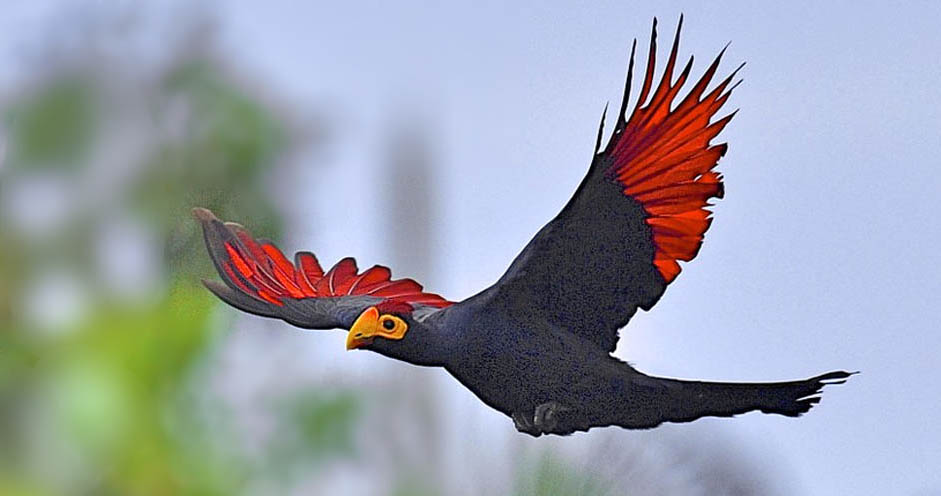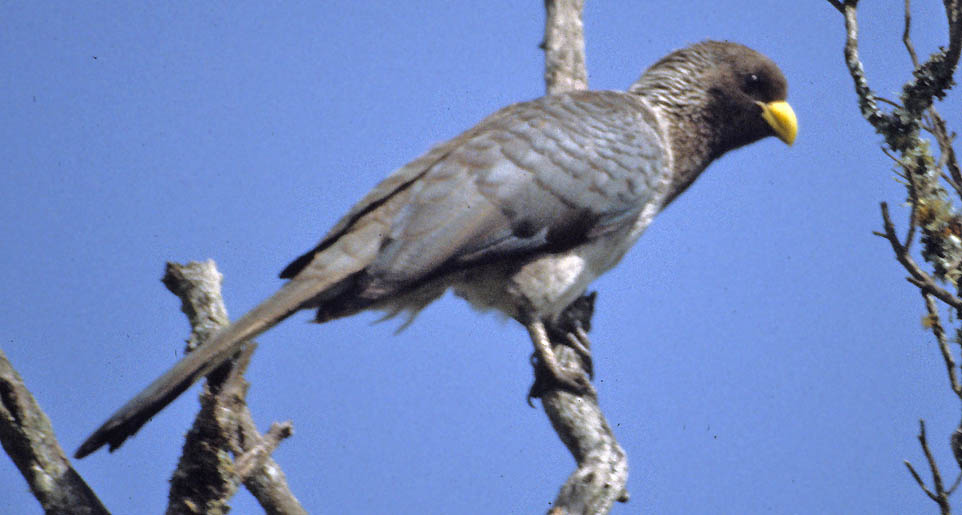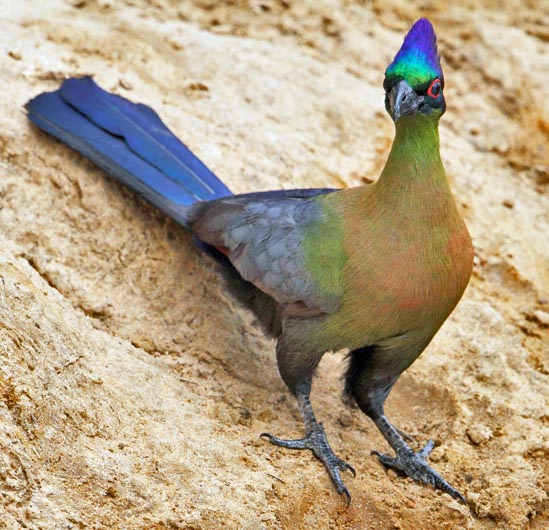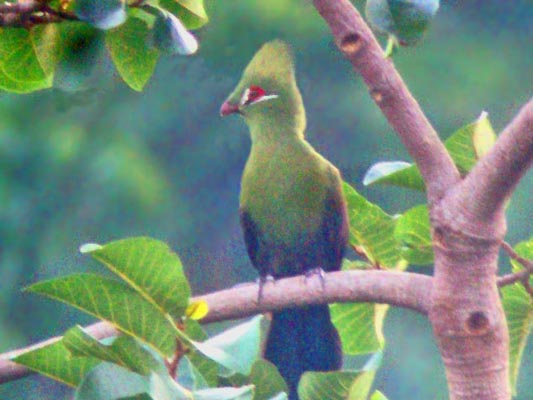
a web page by Don Roberson |
TURACOS Musophagidae |
|
Genetic evidence arranges the 23 species of Turacos into 3 subfamilies (Turner 1997, Veron & Winney 2000, Njabo & Sorenson 2009). The majority of the family (17 species) are in the Musophaginae, exemplified here by this Purple-crested Turaco (left) in a lovely shot by Adam Riley. All members of the Musophaginae subfamily have patches of deep red in the wings. This is often hidden when the bird is perched (e.g., almost imperceptible on the Purple-crested Turaco at left in this stance), but these brilliant swatches of color are obvious in flight. These striking wings and a bright red crest make Ross's Turaco — a bird of gallery forests along rivers in central and eastern Africa — a truly spectacular bird (brilliantly photographed below by Gunnar Pettersson). |
 |
A truly remarkable feature of turacos is the presence of red turacin and green turacoverdin, primarily in the forest-dwelling species. These a two copper-based pigment which are unique to turacos in the entire Animal Kingdom. The amount of these two pigments in each species is related to habitat — those with much of both pigments live in luxurious forest habitats. Turacin, a copper complex of an organic substances, called uroporphyrin. Turacos extract copper content from the fruit they eat and deposit it as pigment in their feathers. (Turner 1997). Turacos of open country, such as this Eastern Plantain-eater (below is a nice photo Dale Zimmerman), do not deposit the copper pigment in feathers. |
 |
The final subfamily of turacos is Corythaeolinae, with its single species Great Blue Turaco (right). It is the largest turaco by far, and resides in the canopy of lowland to montane rain forest and patches of gallery forest along rivers in central and western Africa. I've seen it several places from Ghana to the Kakamega Forest of Kenya (this photo, right), but it hides well in the canopy where it eats small fruits. It has a black crest, yellow bill (hard to see here but it is facing us), and a blue head, neck, upperparts and huge long tail. According to Prum et al. (2015), Great Blue Turaco is a very ancient lineage and diverged from all remaining turacos about 24 million years ago. In this era when species as young as 10 mya are proposed as families [e.g., Yellow-breasted Chat Icteria virens and several others among nine-primaried New World passerines; Barker et al. 2013], we should keep in mind just how ancient some current subfamilies can be. |
Photos: Adam Riley photographed the Purple-crested Turaco Tauraco porphyreolophus at Mkuzi, South Africa. Gunnar Pettersson photographed the flying Ross's Turaco Musophaga rossae near Entebbe, Uganda, on 8 Nov 2011. The Guinean Turaco Tauraco persa was digiscoped in the Shai Hills, Ghana, on 28 Nov 2013. Dale Zimmerman photographed the Eastern Plantain-eater Crinifer zonurus at Kisumu, Kenya, in Sep 1982. The Great Blue Turaco Corythaeola cristata was in the Kakamega Forest in Nov 1982. Bibliographic note: There is no "family book" for this small family but a fine introduction to the family's attributes (but not current as its evolution) is in the Handbook of the Birds of the World series (Turner 1997). Literature cited:
|
 The
Turacos are an amazing and ancient lineage. Their nearest relatives may
be cuckoos and bustards but they diverged from all of these not long
after the Cretaceous-Paleogene extinction event (the old "K-T"
boundary), when an asteroid or comet hit the earth 66 mya (Prum et al.
2015, Claramunt & Cracraft 2015). With the extinction of the
non-avian dinosaurs, new bird groups flourished, including Turacos.
They are now considered to be so ancient and distinctive that they form
the order Musophagiformes.
The
Turacos are an amazing and ancient lineage. Their nearest relatives may
be cuckoos and bustards but they diverged from all of these not long
after the Cretaceous-Paleogene extinction event (the old "K-T"
boundary), when an asteroid or comet hit the earth 66 mya (Prum et al.
2015, Claramunt & Cracraft 2015). With the extinction of the
non-avian dinosaurs, new bird groups flourished, including Turacos.
They are now considered to be so ancient and distinctive that they form
the order Musophagiformes. Ross's
Turaco was among my "most wanted" birds on my first trip to Africa in
1981, and I recall being overwhelmed by this gorgeous bird near the
Mara River in Kenya. White-crested Turaco T. leucolphus is
also quite wonderful; it is restricted to a band of wooded savanna from
Nigeria to Uganda. And one cannot overlook the lovely, mostly
green-with-red-wings turacos that reside primarily in dense tropical
forests. One example is Guinean Turaco of west Africa (right).
Ross's
Turaco was among my "most wanted" birds on my first trip to Africa in
1981, and I recall being overwhelmed by this gorgeous bird near the
Mara River in Kenya. White-crested Turaco T. leucolphus is
also quite wonderful; it is restricted to a band of wooded savanna from
Nigeria to Uganda. And one cannot overlook the lovely, mostly
green-with-red-wings turacos that reside primarily in dense tropical
forests. One example is Guinean Turaco of west Africa (right). The two plantain-eaters — Eastern in east Africa and Western in west Africa — and three species of Go-away-birds [genus Corythaixoides]
comprise the subfamily Criniferinae. All are rather large turacos of
open country whose plumages are combinations of gray, white, and/or
pale brown. Many turacos are called "louries" in parts of Africa, and
the all-gray Gray Go-away-bird of southern Africa is particularly
widely known as "Gray Lourie." All go-away-birds utter loud, plaintive,
nasal notes that can be rendered in English as "g-waaay" or similar
sounds. Throughout southern African, Gray Go-away-bird has an ill
repute with hunters, on claims that it deliberately warns wild game of
a hunter's approach. Turner (1997) notes that it does seem that
antelopes and other ungulates become alert when they hear the loud
cries.
The two plantain-eaters — Eastern in east Africa and Western in west Africa — and three species of Go-away-birds [genus Corythaixoides]
comprise the subfamily Criniferinae. All are rather large turacos of
open country whose plumages are combinations of gray, white, and/or
pale brown. Many turacos are called "louries" in parts of Africa, and
the all-gray Gray Go-away-bird of southern Africa is particularly
widely known as "Gray Lourie." All go-away-birds utter loud, plaintive,
nasal notes that can be rendered in English as "g-waaay" or similar
sounds. Throughout southern African, Gray Go-away-bird has an ill
repute with hunters, on claims that it deliberately warns wild game of
a hunter's approach. Turner (1997) notes that it does seem that
antelopes and other ungulates become alert when they hear the loud
cries.